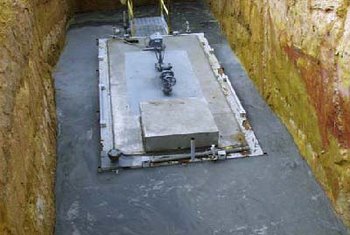Cementitious Barrier Partnership – CBP
The Cementitious Barriers Partnership (CBP) works to improve understanding and prediction of the long-term structural, hydraulic, and chemical performance of cementitious materials and waste forms used primarily in nuclear waste disposal. The objective of the CBP is to develop a set of computational tools – LeachXS, ORCHESTRA, THAMES, STADIUM – that are expected to reduce the uncertainties of current methodologies for performance assessment. CBP is a collaborative program sponsored by the EM Office of Waste Processing, CRESP.ORG and Vanderbilt University.
Investigators:
D. S. Kosson (Lead), S. Mahadevan, A. C. Garrabrants, K. G. Brown, J. R. Arnold, and S. Sarkar (Vanderbilt) and H. van der Sloot and J.C.L. Meeussen (ECN) in collaboration with U.S. Nuclear Regulatory Commission, National Institute of Standards and Technology, Savannah River National Laboratory , and SIMCO Technologies, Inc.
The CBP is a major initiative with the program being jointly led by CRESP (Vanderbilt) and SRNL. CRESP is funding the effort by Vanderbilt and ECN as part of the CBP; SRNL is directly funded by DOE-EM; NRC is self-funded; and, NIST and SIMCO are funded by an interagency agreement between DOE-EM and NIST.
Partners:
 Department of Energy Office of Environmental Management: Savannah River Nuclear Solutions, LLC
Department of Energy Office of Environmental Management: Savannah River Nuclear Solutions, LLC
Vanderbilt University Department of Civil and Environmental Engineering, and the Consortium for Risk Evaluation with Stakeholder Participation (CRESP)
The National Institute of Standards and Technology (NIST)
U.S. Nuclear Regulatory Commission (NRC)
Energy Research Centre of the Netherlands (ECN)
SIMCO Technologies, Inc (SIMCO)
Project Objectives:
A credible set of simulation and modeling tools is being developed to predict the structural, hydraulic, and chemical performance of cement barriers used in nuclear applications over extended time frames (e.g., >100 years for operating facilities and >1000 years for waste management). The results will enable improved risk-informed, performance-based decision making and are applicable to Hanford and Savannah River Site closure activities as well as at other DOE sites and future nuclear facilities (leverage with NRC and DOE-NE).
Specific project objectives for Vanderbilt and ECN are (i) development and demonstration of an uncertainty quantification framework, (ii) laboratory experiments to quantify effects of degradation processes on material performance and provide model parameters, (iii) demonstrate and improve LeachXS™ as a tool for assessing contaminant release from relevant DOE-EM systems, and (iv) facilitate model integration into a GoldSim tool jointly with SRNL.
Relevance and Impact to DOE:
PA analyses show that engineered barriers are required to prevent the radionuclide release from near surface nuclear facilities into the environment. In the absence of adequate predictive tools, assessments cannot fully incorporate the effectiveness of cement barriers used in containment and/or as part of the waste zone. This limits the inventory of radionuclides that may be safely disposed of in shallow land disposal and the predicted service life of operating nuclear facilities. The characteristics of diverse cementitious materials when they serve as matrices for or barriers to release of contaminants is a national issue affecting those disposal sites that use cementitious waste forms and concrete and grout structures and / or that are performing D&D activities, service life determination of existing structures, and design of future public and private nuclear facilities. Tools developed by CBP are also applicable to closure of major facilities (e.g., canyons and basins) and in-situ immobilization of contaminated vadose zone materials and also the use of those materials in new nuclear facilities. CBP efforts will also enable improved risk-informed, performance-based decision making for the next generation commercial nuclear reactor waste disposal.
One significant benefit to DOE is the collaborative effort and information exchange among CBP partners resulting in early identification and resolution of key technical issues and uncertainties, improved transparency, credibility, and acceptance of the methodologies adopted by DOE. This is anticipated to streamline review and acceptance of DOE PAs.
Additional benefits will include: more efficient use of materials and improved designs; reduced uncertainty from improved conceptual models, computational models, and data; shorter analysis time due to integration of simulation components; shorter review time and clearer stakeholder interactions because of improved transparency; and reduced potential for human error through the integration of process steps. Finally, CBP processes and organizational characteristics may well also serve as a model for similar evaluation of other waste form and/or barrier materials.
Reports
QUALITY ASSURANCE PROGRAM: CEMENTITIOUS BARRIERS PARTNERSHIP (CBP) December 2008 — CBP-01
J. P. Vaughan, Savannah River National Laboratory, Savannah River Nuclear Solutions, LLC, Savannah River Site, Aiken, SC
DOWNLOAD
REFERENCE CASES FOR USE IN THE CEMENTITIOUS BARRIERS PARTNERSHIP
SRNL-STI-2009-00005 WM 2009 March 1-5, Phoenix, AZ
Christine A. Langton, Savannah River National Laboratory; David S. Kosson, CRESP and Vanderbilt University, Andrew C. Garrabrants, CRESP and Vanderbilt University, and Kevin G. Brown, CRESP and Vanderbilt University
DOWNLOAD OSTI Description
OVERVIEW OF THE U.S. DEPARTMENT OF ENERGY AND NUCLEAR REGULATORY COMMISSION PERFORMANCE ASSESSMENT APPROACHES
May 2009 — CBP-TR-2009-001, Rev.0
DOWNLOAD OSTI Description
REVIEW OF MECHANISTIC UNDERSTANDING AND MODELING AND UNCERTAINTY ANALYSIS METHODS FOR PREDICTING CEMENTITIOUS BARRIER PERFORMANCE
November 2009 — CBP-TR-2009-002, Rev.0
DOWNLOAD OSTI Description
DESCRIPTION OF THE SOFTWARE AND INTEGRATING PLATFORM
December 2009 — CBP-TR-2009-003, Rev. 0
DOWNLOAD OSTI Description
CEMENTITIOUS BARRIERS PARTNERSHIP TASK 7 DEMONSTRATION OF THAMES FOR MICROSTRUCTURE AND TRANSPORT PROPERTIES
March 2010 — CBP-TR-2010-007-C2, Rev. 0
DOWNLOAD OSTI Description
PROBABILISTIC DURABILITY ANALYSIS OF CEMENTITIOUS MATERIALS UNDER EXTERNAL SULFATE ATTACK
Sohini Sarkar
Ph.D. Dissertation, Vanderbilt University, August 2010
View Abstract
